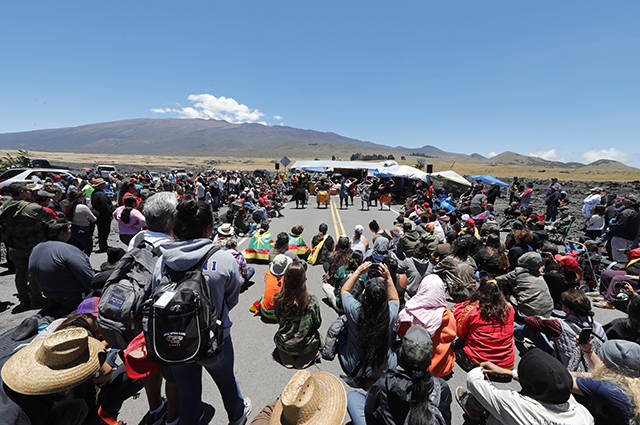Mayor Harry Kim releases his Mauna Kea plan, which includes TMT

JAMM AQUINO/JAQUINO@STARADVERTISER.COM
People gather to watch a kahiko performance at during protests against the Thirty Meter Telescope on July 23, 2019 at the base of Mauna Kea. Hawaii County Mayor Harry Kim released his plan today for resolving the controversy stemming from the telescope.

COURTESY PHOTO
The cover of Hawaii County Mayor Harry Kim’s plan for resolving the controversy surrounding Mauna Kea.


HILO >> Hawaii County Mayor Harry Kim officially released his long-awaited plan for resolving the controversy surrounding Mauna Kea today, proposing in a pamphlet that the site designated for the $1.4 billion Thirty Meter Telescope should be the last area of the mountain that is ever developed for a telescope.
But it appears unlikely Kim’s plan will win quick or easy acceptance from the TMT opponents. Kaho‘okahi Kanuha, a leader of the protests on Mauna Kea, said earlier this month if Kim’s proposal assumes that TMT will be built, “there’s no way that works.”
“I’m not sure how he believes that to be representative of the people, and how that would in any way work towards finding a solution to the current issue, which is the building of TMT,” Kanuha said at the time.
Gov. David Ige announced on July 23 he had asked Kim to develop a plan to resolve the dispute on Mauna Kea, where anti-TMT activists have been camped for months on the access road to prevent construction equipment and crews from starting work on TMT near the summit.
The access road has been closed since July 15, and dozens of anti-TMT activists were arrested July 17 for blocking the roadway. The protesters regard the project as a desecration of a mountain that many Hawaiians consider sacred, and say they will not allow TMT to be built.
Supporters of TMT, meanwhile, say the project has a legal right to proceed. It took the TMT sponsors a decade to obtain permission from the state and county to proceed with the project.
Don't miss out on what's happening!
Stay in touch with breaking news, as it happens, conveniently in your email inbox. It's FREE!
Kim’s plan for resolving that dispute is entitled “The Heart of Aloha, A Way Forward Maunakea,” and it incorporates some steps that have already been proposed or promised, including the decommissioning and removal of five of the 13 observatories now on the mountain.
The document also recaps plans to develop rules to regulate commercial activities on Mauna Kea and the number of people who visit the mountain, and notes that TMT will pay much more in lease rent than the other observatories — with payments starting at at $300,000 annually, and ramping up to $1.08 million annually after 10 years. Other observatories pay only $1 a year.
It also recaps the community benefits that TMT has pledged to provide, including the launch of the TMT International Observatory’s THINK Fund to provide $1 million a year to STEM education on Hawaii island.
Also included in the document are pledges by Ige to administratively overhaul the governance of the mountain to include representation by the Hawaiian community and county government; and by University of Hawaii President David Lassner to establish a center at the Hale Pohaku visitors center “to celebrate and honor Hawaiian history, knowledge, culture and language, along with modern science and astronomy.”
The document calls for the convening of “a core group of community members who believe and support the vision. The responsibilities of this group are to provide direction and guidance in bringing this vision to life.”
The Mauna Kea protests have mobilized many in the Hawaiian community, and Kim said in his proposal the mountain has contributed to the “Hawaiian cultural renaissance, the Hawaiians’ identity and the pride of being Hawaiian; with this, the reverence and sacredness for the total environment.”
“When respectfully integrated with a comprehensive understanding of Maunakea and Hawaiian culture, astronomy can be such a catalyst for positive and transformational changes in Hawai‘i,” the plan states. “Under the leadership of dreamers, innovators, and awakened community, this can be the leverage for not only Maunakea issues, but to understand and address wrongs of past to make us a better people and place.”
A Star-Advertiser poll published last week shows that as the protests have continued, public support for the TMT has been eroding.
Half of all voters surveyed in the poll still support plans to build the telescope, but that is a significant decline from 18 months ago when 77% of voters said they supported the project. The poll found Hawaiians object most to the project, with 62% now saying they oppose construction of the TMT.
Slightly more than half of all voters approve of the protests, which are designed to prevent the TMT from ever being built.
Ige has pledged to reopen the road and “enforce the law” so that construction can proceed, but the poll found 59% of Hawaii voters oppose the use of force to reopen the road.
Mauna Kea Booklet by Honolulu Star-Advertiser on Scribd



